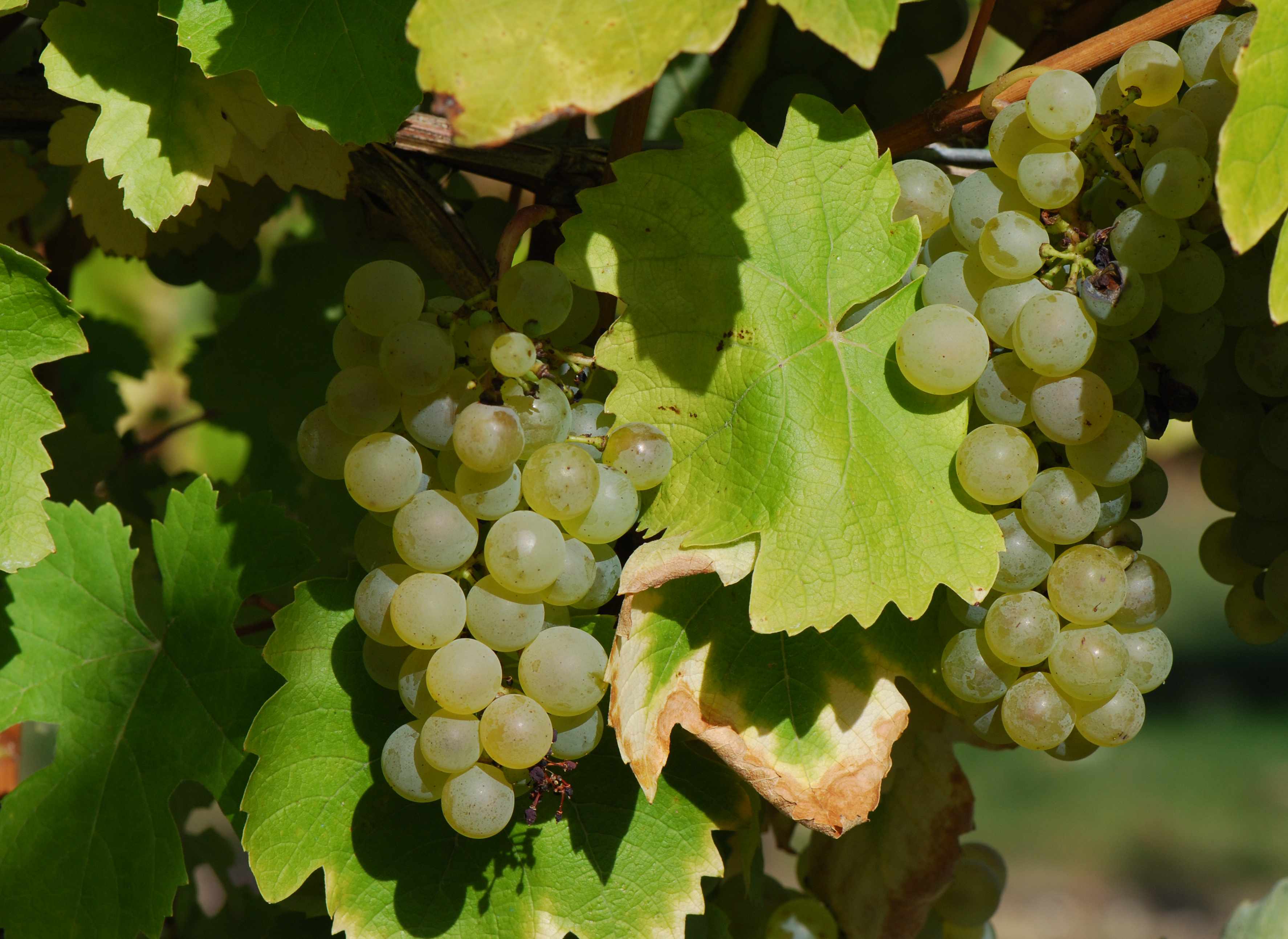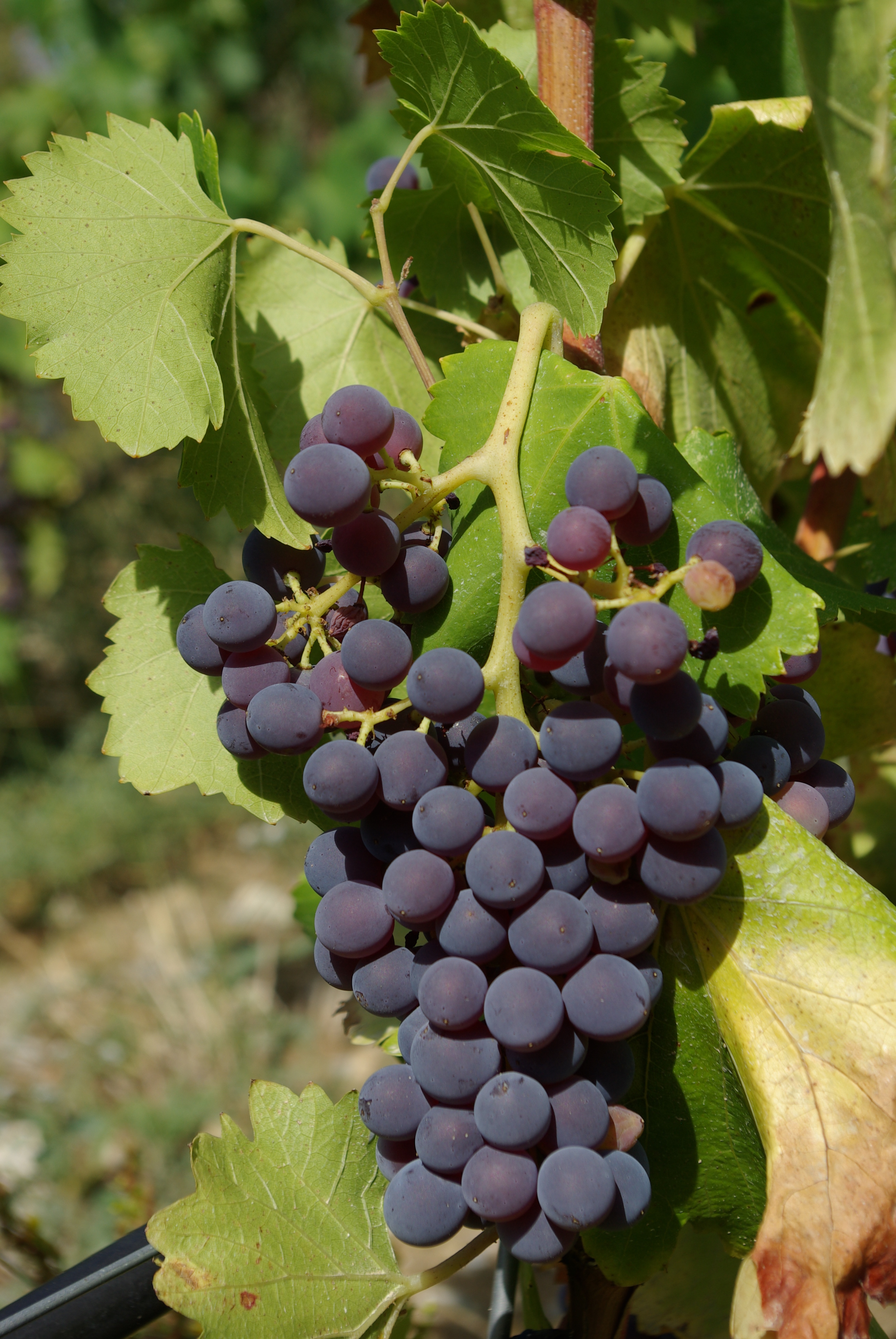|
Merlot Blanc
Merlot blanc is a white French wine grape variety that came from a natural crossing of the Bordeaux wine grape Merlot and the Cognac grape Folle blanche. The grape is distinct from ''Merlot gris'' which is a pink-skinned color mutation of the red wine grape Merlot and is sometimes used in ''vin gris'' and rosé wines. Plantings of Merlot blanc were first discovered in 1891 but cuttings of the vine have not been widely propagated and the variety is very rare. It is not used to make the sweet White Zinfandel-style wine ''White Merlot'' that is made by some California wine producers. Those wines are made from a '' saignee'' of red Merlot wine. Relationship to other grapes When Merlot blanc was first discovered, it was thought that the vine was a white-berried color mutation of Merlot in a similar relation to how Grenache blanc is a color mutation of Grenache and Pinot blanc is a mutation of Pinot noir. However, DNA analysis conducted by the University of California-Davis and ... [...More Info...] [...Related Items...] OR: [Wikipedia] [Google] [Baidu] |
French Wine
French wine is produced all throughout France, in quantities between 50 and 60 million hectolitres per year, or 7–8 billion bottles. France is one of the largest wine producers in the world, along with Italian, Spanish, and American wine-producing regions. French wine traces its history to the 6th century BCE, with many of France's regions dating their wine-making history to Roman times. The wines produced range from expensive wines sold internationally to modest wines usually only seen within France such as the Margnat wines of the post war period. Two concepts central to the better French wines are the notion of ''terroir'', which links the style of the wines to the locations where the grapes are grown and the wine is made, and the ''Appellation d'origine contrôlée'' (AOC) system, replaced by the Appellation d'Origine Protégée (AOP) system in 2012. Appellation rules closely define which grape varieties and winemaking practices are approved for classification ... [...More Info...] [...Related Items...] OR: [Wikipedia] [Google] [Baidu] |
Grenache
Grenache () or Garnacha () is one of the most widely planted red wine grape varieties in the world. Niels Lillelund: ''Rhône-Vinene'' p. 25, JP Bøger – JP/Politikens Forlagshus A/S, 2004. . It ripens late, so it needs hot, dry conditions such as those found in Spain, where the grape most likely originated. It is also grown in the Italian island of Sardinia, the south of France, Australia, and California's Monterey AVA and San Joaquin Valley. It is generally spicy, berry-flavored and soft on the palate and produces wine with a relatively high alcohol content, but it needs careful control of yields for best results. Characteristic flavor profiles on Grenache include red fruit flavors (raspberry and strawberry) with a subtle, white pepper spice note. Grenache wines are highly prone to oxidation, with even young examples having the potential to show browning (or "bricking") coloration that can be noticed around the rim when evaluating the wine at an angle in the glass. As ... [...More Info...] [...Related Items...] OR: [Wikipedia] [Google] [Baidu] |
Merlot Equinox
Merlot is a dark blue–colored wine grape variety, that is used as both a blending grape and for varietal wines. The name ''Merlot'' is thought to be a diminutive of ''merle'', the French name for the blackbird, probably a reference to the color of the grape. Its softness and "fleshiness," combined with its earlier ripening, make Merlot a popular grape for blending with the sterner, later-ripening Cabernet Sauvignon, which tends to be higher in tannin. Along with Cabernet Sauvignon, Cabernet Franc, Malbec and Petit Verdot, Merlot is one of the primary grapes used in Bordeaux wine, and it is the most widely planted grape in the Bordeaux wine regions. Merlot is also one of the most popular red wine varietals in many markets. This flexibility has helped to make it one of the world's most planted grape varieties. As of 2004, Merlot was estimated to be the third most grown variety at globally.J. Robinson (ed) ''The Oxford Companion to Wine'' Third Edition, Oxford University ... [...More Info...] [...Related Items...] OR: [Wikipedia] [Google] [Baidu] |
Armagnac (province)
The County of Armagnac (, ; oc, label= Gascon, Armanhac), situated between the Adour and Garonne rivers in the lower foothills of the Pyrenées, was a historic county of the Duchy of Gascony, established in 601 in Aquitaine (now France). In 960, the title of 'Count of Armagnac' was established, and thus the County of Armagnac was created. In 1751, following the death of childless Charles de Lorraine, Comte d'Armagnac, the county was absorbed into the Crown lands of France and the King, then Louis XV took the title of 'Count of Armagnac' (''Comte d'Armagnac''). In 1791, following the Decree dividing France into departments, the county was disestablished, but remains an important natural region of France. History Under Roman rule, Armagnac was included in the Civitas Ausciorum, or district of Auch, of Aquitania. Under the Merovingians it was part of the duchy of Aquitania. Near the end of the ninth century the part now known as Fezensac became a hereditary county. In 960, ... [...More Info...] [...Related Items...] OR: [Wikipedia] [Google] [Baidu] |
Genetic Marker
A genetic marker is a gene or DNA sequence with a known location on a chromosome that can be used to identify individuals or species. It can be described as a variation (which may arise due to mutation or alteration in the genomic loci) that can be observed. A genetic marker may be a short DNA sequence, such as a sequence surrounding a single base-pair change ( single nucleotide polymorphism, SNP), or a long one, like minisatellites. Background For many years, gene mapping was limited to identifying organisms by traditional phenotypes markers. This included genes that encoded easily observable characteristics such as blood types or seed shapes. The insufficient number of these types of characteristics in several organisms limited the mapping efforts that could be done. This prompted the development of gene markers which could identify genetic characteristics that are not readily observable in organisms (such as protein variation). Types Some commonly used types of genetic markers ... [...More Info...] [...Related Items...] OR: [Wikipedia] [Google] [Baidu] |
Charente
Charente (; Saintongese: ''Chérente''; oc, Charanta ) is a department in the administrative region of Nouvelle-Aquitaine, south western France. It is named after the river Charente, the most important and longest river in the department, and also the river beside which the department's two largest towns, Angoulême and Cognac, are sited. In 2019, it had a population of 352,015.Populations légales 2019: 16 Charente INSEE History Charente is one of the original 83 departments created during the on 4 March 1790. It was created from the[...More Info...] [...Related Items...] OR: [Wikipedia] [Google] [Baidu] |
Brittany
Brittany (; french: link=no, Bretagne ; br, Breizh, or ; Gallo language, Gallo: ''Bertaèyn'' ) is a peninsula, Historical region, historical country and cultural area in the west of modern France, covering the western part of what was known as Armorica during the period of Roman occupation. It became an Kingdom of Brittany, independent kingdom and then a Duchy of Brittany, duchy before being Union of Brittany and France, united with the Kingdom of France in 1532 as a provinces of France, province governed as a separate nation under the crown. Brittany has also been referred to as Little Britain (as opposed to Great Britain, with which it shares an etymology). It is bordered by the English Channel to the north, Normandy to the northeast, eastern Pays de la Loire to the southeast, the Bay of Biscay to the south, and the Celtic Sea and the Atlantic Ocean to the west. Its land area is 34,023 km2 . Brittany is the site of some of the world's oldest standing architecture, ho ... [...More Info...] [...Related Items...] OR: [Wikipedia] [Google] [Baidu] |
Cabernet Franc
Cabernet Franc is one of the major black grape varieties worldwide. It is principally grown for blending with Cabernet Sauvignon and Merlot in the Bordeaux style, but can also be vinified alone, as in the Loire's Chinon. In addition to being used in blends and produced as a varietal in Canada and the United States, it is sometimes made into ice wine in those regions. Cabernet Franc is lighter than Cabernet Sauvignon, making a bright pale red wine that contributes finesse and lends a peppery perfume to blends with more robust grapes. Depending on the growing region and style of wine, additional aromas can include tobacco, raspberry, bell pepper, cassis, and violets. Records of Cabernet Franc in Bordeaux go back to the end of the 18th century, although it was planted in Loire long before that time. DNA analysis indicates that Cabernet Franc is one of two parents of Cabernet Sauvignon, Merlot, and Carménère. History Cabernet Franc is believed to have been established in the ... [...More Info...] [...Related Items...] OR: [Wikipedia] [Google] [Baidu] |
Carole Meredith
Carole P. Meredith is an American grape geneticist and was a professor at the Department of Viticulture and Enology of University of California, Davis. Career Before she retired in 2003, Meredith and her research group pioneered the use of DNA typing to differentiate ''Vitis vinifera'' grape varieties and for elucidating their parentage, which gives insight into the varieties' history and place of origin. In 1996, Meredith and her research established the parentage of Cabernet Sauvignon, which was the first application of such techniques. Later, Chardonnay, Syrah, and Zinfandel followed.Lagier-Meredith: Who we are The research group showed that the varieties , |
Ampelographers
Ampelography ( ἄμπελος, "vine" + γράφος, "writing") is the field of botany concerned with the identification and classification of grapevines, ''Vitis'' spp. Traditionally this has been done by comparing the shape and colour of the vine leaves and grape berries; more recently the study of vines has been revolutionised by DNA fingerprinting. Early history The grape vine is an extremely variable species and some varieties, such as Pinot, mutate particularly frequently. At the same time, the wine and table grape industries have been important since ancient times, so large sums of money can depend on the correct identification of different varieties and clones of grapevines. The science of ampelography began seriously in the 19th century, when it became important to understand more about the different species of vine, as they had very different resistance to disease and pests such as phylloxera. Many vine identification books were published at this time, one of which ... [...More Info...] [...Related Items...] OR: [Wikipedia] [Google] [Baidu] |
University Of California-Davis
The University of California, Davis (UC Davis, UCD, or Davis) is a public land-grant research university near Davis, California. Named a Public Ivy, it is the northernmost of the ten campuses of the University of California system. The institution was first founded as an agricultural branch of the system in 1905 and became the seventh campus of the University of California in 1959. The university is classified among "R1: Doctoral Universities – Very high research activity". The UC Davis faculty includes 23 members of the National Academy of Sciences, 30 members of the American Academy of Arts and Sciences, 17 members of the American Law Institute, 14 members of the Institute of Medicine, and 14 members of the National Academy of Engineering. Among other honors that university faculty, alumni, and researchers have won are two Nobel Prizes, one Fields Medal, a Presidential Medal of Freedom, three Pulitzer Prizes, three MacArthur Fellowships, and a National Medal of Science. F ... [...More Info...] [...Related Items...] OR: [Wikipedia] [Google] [Baidu] |



.jpg)